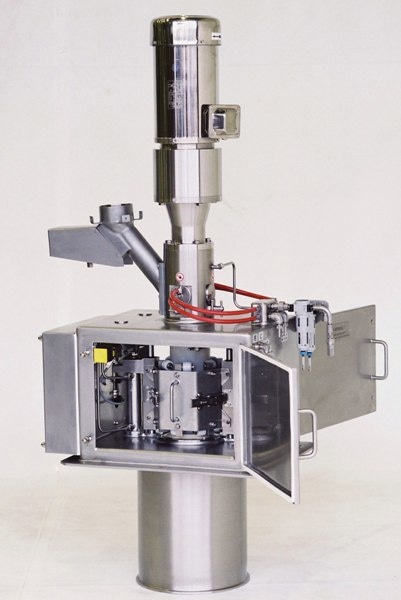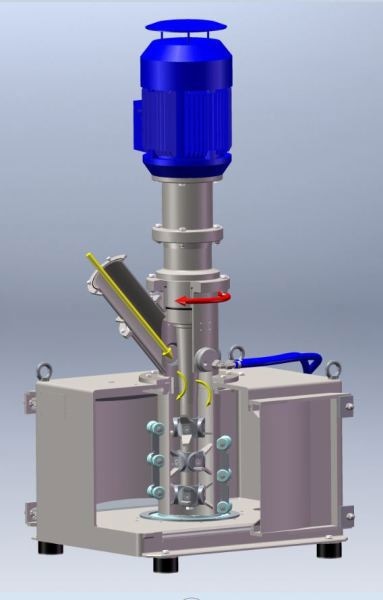Agglomeration refers to the process of enlargement of particle sizes where fine powder particles are coupled to form large, permanent masses wherein original particles can still be identified.
Such agglomerates exhibit a coarse and open structure and have a mean particle size, which ranges from 0.1 to a few millimeters. This procedure utilizes agitation in the presence of the required characteristics of binding agents such as a liquid phase and is usually followed by evaporative drying.
For instance, in applications where rapid mixing is required and instant dispersion, dissolution and wetting are critical in the end use of products. Powders that can be used in this process comprise mostly water soluble powders, including water soluble chemicals, milk powder blends and sugars.
Benefits
The aim of particle size enlargement process is to create particles that have the desired end use properties, like simple de- dusting, to develop particles of specific shape, size, compressibility/dissolving rate, and density.
Instant Mixing Agglomeration
Instant mixing agglomeration is a kind of wet agglomeration process, which means liquid and powders need to be used in the process and generally includes drying, mixing, conditioning, size classification, size reduction and transport of material.
Mixing
Instant mixing agglomeration helps in controlling the mixing conditions which leads to perfectly formed uniform granules. Through high level mixing intensity, instant mixing agglomeration not only allows homogeneous wetting of particles, but also delivers even particle growth.
Since newly formed wet agglomerate is flexible, particles can be easily deformed. Hence, it is necessary to ensure that residence in the mixer is restricted between 0.2 seconds and up to a few seconds.
Saturated powders tend to have very poor flow properties, which can result in mixer blockage. This can be overcome by using a self-cleaning mixer. However, inadequate cleaning of material from the wall can result in uneven product characteristics, which when used appear as undissolved and undispersed product.
Liquids are often introduced close to the feed end of the agglomerator. Air can be used to atomize the liquid feed stream or steam can also be injected. The residual mechanical atomization are provided by the mixer itself to disperse the fluid.
Conditioning
Typically, mixed and agglomerated product is discharged to a conditioner such as a dryer to stabilize the agglomerate. Given the flexible nature of the wet granule, manual handling can impact the product shape, size, density and quality. Additional mechanical handling techniques also need to be carefully considered to obtain the preferred end product qualities. Options available for additional processing subsequent to the wet agglomeration step include drying, cooling and forming.
Drying
When no additional sizing is needed and a dispersible granule with the highest surface area is needed for products such as instant beverages and chemicals, fluidbed drying is usually preferred as it provides maximum drying rate and minimal mechanical force.
Wet granules are suspended and enclosed by drying air. The fluidbed dryer efficiently categorizes the particle returning fines to the agglomerator for rewetting, which results in a dust-free product (Figure 1).


Figure 1. Fluidbed dryer
Cooling and Forming
Cooling stabilizes the malleable granules. The rapid mixing process is efficient when creating a fine agglomerate in the range of 100 to 1000µm. Thanks to the rapid forming process, the agglomerates become clusters of smaller particles. Due to the uneven surface, more surface area will be seen in the instant agglomerate when compared to a solid, uniform granule. Such properties help in compressibility and rapid dispersion of the agglomerate. If a more defined shape is needed, another forming process before conditioning can be carried out.
Application: Chocolate Drinks
Over the past decades, the consumption of cocoa in chocolate drinks has increased significantly and this is because a number of products have been developed that make it easier to add cocoa powder into cold and hot drinks. These products should have instant properties. The end product is judged by the following criteria:
- Colour
- Bulk density
- Wettability
- Flowability
- Dispersibility
- Sinkability
- Appearance
- Homogeneity of product, no segregation
- Dissolving time in cold or hot liquids
Agglomeration Process
Prior to agglomeration, all powdery components should be blended. This can be performed in several ways depending on the manufacturing capacity. For a manufacturing capacity between 500 and 1000kg/h, the most convenient way is use a Vrieco Nauta Conical Mixer to pre- blend all the powdery components. Once pre-blending is over, the mixture is fed to a buffer hopper and from this hopper, the blend is added to the Flexomix agglomerator, in the right proportion using a constant weight feeder.
For agglomeration with water, 2 to 8% of water is required. This is a critical parameter which can affect the grain size of the product. Instant cocoa has a grain size between 300 and 600µm. Using water along with steam renders unique quality properties on the final product. By means of a liquid premix tank, flavours and emulsifiers can be dissolved in water. Also, part of the sugar can be dissolved in the water, which affects the instant effect.
Next, the wet granules fall from the Flexomix into the Fluidbed Dryer and warm drying air is blown via the perforated base plates. The maximum temperature of the product and the temperature of the drying air during the drying process are major factors to achieve the desired taste and quality of the final product.
After passing the fluidbed’s drying section, the product travels to the cooling section in the same bed. Cooling is performed by conditioned air or ambient air, depending on the behaviour of the final product. Then, the blow-over air is cleaned by a filter and exhausted, and the isolated dust is gathered in a small hopper or transmitted to the packing line, along with the on-size product.
Subsequent to cooling, the product is discharged from the Fluidbed Dryer and passes a sieve to prevent any oversize particles which may be otherwise present. Next, the oversize is crushed and added to the stream of end product. The entire end product stream is fed to a storage hopper from where it is transferred to the packing lines. The entire Agglomeration Plant is managed by a SCADA system.
Conclusion
The goal of any particle size enlargement process is to consistently create particles that have the required end use properties to design particle of specific shape, size, density, dissolving rate and compressibility.

This information has been sourced, reviewed and adapted from materials provided by Hosokawa Micron.
For more information on this source, please visit Hosokawa Micron.